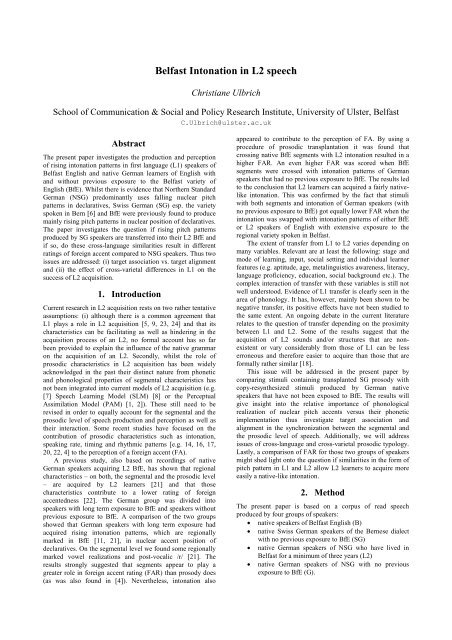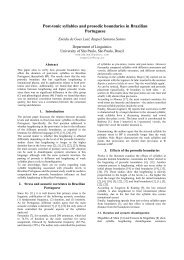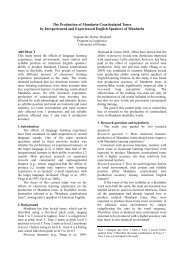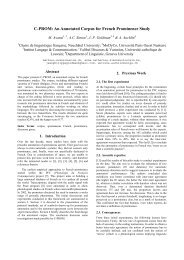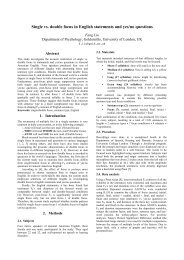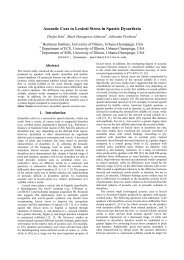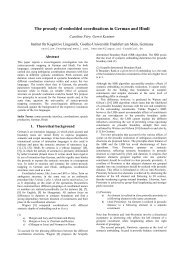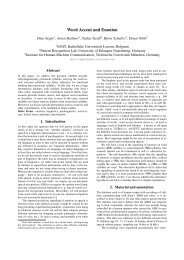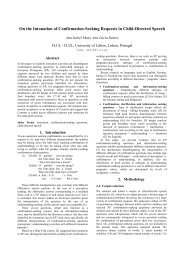Belfast Intonation in L2 speech - Speech Prosody 2010
Belfast Intonation in L2 speech - Speech Prosody 2010
Belfast Intonation in L2 speech - Speech Prosody 2010
Create successful ePaper yourself
Turn your PDF publications into a flip-book with our unique Google optimized e-Paper software.
<strong>Belfast</strong> <strong>Intonation</strong> <strong>in</strong> <strong>L2</strong> <strong>speech</strong><br />
Christiane Ulbrich<br />
School of Communication & Social and Policy Research Institute, University of Ulster, <strong>Belfast</strong><br />
C.Ulbrich@ulster.ac.uk<br />
Abstract<br />
The present paper <strong>in</strong>vestigates the production and perception<br />
of ris<strong>in</strong>g <strong>in</strong>tonation patterns <strong>in</strong> first language (L1) speakers of<br />
<strong>Belfast</strong> English and native German learners of English with<br />
and without previous exposure to the <strong>Belfast</strong> variety of<br />
English (BfE). Whilst there is evidence that Northern Standard<br />
German (NSG) predom<strong>in</strong>antly uses fall<strong>in</strong>g nuclear pitch<br />
patterns <strong>in</strong> declaratives, Swiss German (SG) esp. the variety<br />
spoken <strong>in</strong> Bern [6] and BfE were previously found to produce<br />
ma<strong>in</strong>ly ris<strong>in</strong>g pitch patterns <strong>in</strong> nuclear position of declaratives.<br />
The paper <strong>in</strong>vestigates the question if ris<strong>in</strong>g pitch patterns<br />
produced by SG speakers are transferred <strong>in</strong>to their <strong>L2</strong> BfE and<br />
if so, do these cross-language similarities result <strong>in</strong> different<br />
rat<strong>in</strong>gs of foreign accent compared to NSG speakers. Thus two<br />
issues are addressed: (i) target association vs. target alignment<br />
and (ii) the effect of cross-varietal differences <strong>in</strong> L1 on the<br />
success of <strong>L2</strong> acquisition.<br />
1. Introduction<br />
Current research <strong>in</strong> <strong>L2</strong> acquisition rests on two rather tentative<br />
assumptions: (i) although there is a common agreement that<br />
L1 plays a role <strong>in</strong> <strong>L2</strong> acquisition [5, 9, 23, 24] and that its<br />
characteristics can be facilitat<strong>in</strong>g as well as h<strong>in</strong>der<strong>in</strong>g <strong>in</strong> the<br />
acquisition process of an <strong>L2</strong>, no formal account has so far<br />
been provided to expla<strong>in</strong> the <strong>in</strong>fluence of the native grammar<br />
on the acquisition of an <strong>L2</strong>. Secondly, whilst the role of<br />
prosodic characteristics <strong>in</strong> <strong>L2</strong> acquisition has been widely<br />
acknowledged <strong>in</strong> the past their dist<strong>in</strong>ct nature from phonetic<br />
and phonological properties of segmental characteristics has<br />
not been <strong>in</strong>tegrated <strong>in</strong>to current models of <strong>L2</strong> acquisition (e.g.<br />
[7] <strong>Speech</strong> Learn<strong>in</strong>g Model (SLM) [8] or the Perceptual<br />
Assimilation Model (PAM) [1, 2]). These still need to be<br />
revised <strong>in</strong> order to equally account for the segmental and the<br />
prosodic level of <strong>speech</strong> production and perception as well as<br />
their <strong>in</strong>teraction. Some recent studies have focused on the<br />
contribution of prosodic characteristics such as <strong>in</strong>tonation,<br />
speak<strong>in</strong>g rate, tim<strong>in</strong>g and rhythmic patterns [e.g. 14, 16, 17,<br />
20, 22, 4] to the perception of a foreign accent (FA).<br />
A previous study, also based on record<strong>in</strong>gs of native<br />
German speakers acquir<strong>in</strong>g <strong>L2</strong> BfE, has shown that regional<br />
characteristics – on both, the segmental and the prosodic level<br />
– are acquired by <strong>L2</strong> learners [21] and that those<br />
characteristics contribute to a lower rat<strong>in</strong>g of foreign<br />
accentedness [22]. The German group was divided <strong>in</strong>to<br />
speakers with long term exposure to BfE and speakers without<br />
previous exposure to BfE. A comparison of the two groups<br />
showed that German speakers with long term exposure had<br />
acquired ris<strong>in</strong>g <strong>in</strong>tonation patterns, which are regionally<br />
marked <strong>in</strong> BfE [11, 21], <strong>in</strong> nuclear accent position of<br />
declaratives. On the segmental level we found some regionally<br />
marked vowel realizations and post-vocalic /r/ [21]. The<br />
results strongly suggested that segments appear to play a<br />
greater role <strong>in</strong> foreign accent rat<strong>in</strong>g (FAR) than prosody does<br />
(as was also found <strong>in</strong> [4]). Nevertheless, <strong>in</strong>tonation also<br />
appeared to contribute to the perception of FA. By us<strong>in</strong>g a<br />
procedure of prosodic transplantation it was found that<br />
cross<strong>in</strong>g native BfE segments with <strong>L2</strong> <strong>in</strong>tonation resulted <strong>in</strong> a<br />
higher FAR. An even higher FAR was scored when BfE<br />
segments were crossed with <strong>in</strong>tonation patterns of German<br />
speakers that had no previous exposure to BfE. The results led<br />
to the conclusion that <strong>L2</strong> learners can acquired a fairly nativelike<br />
<strong>in</strong>tonation. This was confirmed by the fact that stimuli<br />
with both segments and <strong>in</strong>tonation of German speakers (with<br />
no previous exposure to BfE) got equally lower FAR when the<br />
<strong>in</strong>tonation was swapped with <strong>in</strong>tonation patterns of either BfE<br />
or <strong>L2</strong> speakers of English with extensive exposure to the<br />
regional variety spoken <strong>in</strong> <strong>Belfast</strong>.<br />
The extent of transfer from L1 to <strong>L2</strong> varies depend<strong>in</strong>g on<br />
many variables. Relevant are at least the follow<strong>in</strong>g: stage and<br />
mode of learn<strong>in</strong>g, <strong>in</strong>put, social sett<strong>in</strong>g and <strong>in</strong>dividual learner<br />
features (e.g. aptitude, age, metal<strong>in</strong>guistics awareness, literacy,<br />
language proficiency, education, social background etc.). The<br />
complex <strong>in</strong>teraction of transfer with these variables is still not<br />
well understood. Evidence of L1 transfer is clearly seen <strong>in</strong> the<br />
area of phonology. It has, however, ma<strong>in</strong>ly been shown to be<br />
negative transfer, its positive effects have not been studied to<br />
the same extent. An ongo<strong>in</strong>g debate <strong>in</strong> the current literature<br />
relates to the question of transfer depend<strong>in</strong>g on the proximity<br />
between L1 and <strong>L2</strong>. Some of the results suggest that the<br />
acquisition of <strong>L2</strong> sounds and/or structures that are nonexistent<br />
or vary considerably from those of L1 can be less<br />
erroneous and therefore easier to acquire than those that are<br />
formally rather similar [18].<br />
This issue will be addressed <strong>in</strong> the present paper by<br />
compar<strong>in</strong>g stimuli conta<strong>in</strong><strong>in</strong>g transplanted SG prosody with<br />
copy-resynthesized stimuli produced by German native<br />
speakers that have not been exposed to BfE. The results will<br />
give <strong>in</strong>sight <strong>in</strong>to the relative importance of phonological<br />
realization of nuclear pitch accents versus their phonetic<br />
implementation thus <strong>in</strong>vestigate target association and<br />
alignment <strong>in</strong> the synchronization between the segmental and<br />
the prosodic level of <strong>speech</strong>. Additionally, we will address<br />
issues of cross-language and cross-varietal prosodic typology.<br />
Lastly, a comparison of FAR for those two groups of speakers<br />
might shed light onto the question if similarities <strong>in</strong> the form of<br />
pitch pattern <strong>in</strong> L1 and <strong>L2</strong> allow <strong>L2</strong> learners to acquire more<br />
easily a native-like <strong>in</strong>tonation.<br />
2. Method<br />
The present paper is based on a corpus of read <strong>speech</strong><br />
produced by four groups of speakers:<br />
native speakers of <strong>Belfast</strong> English (B)<br />
native Swiss German speakers of the Bernese dialect<br />
with no previous exposure to BfE (SG)<br />
native German speakers of NSG who have lived <strong>in</strong><br />
<strong>Belfast</strong> for a m<strong>in</strong>imum of three years (<strong>L2</strong>)<br />
native German speakers of NSG with no previous<br />
exposure to BfE (G).
A total number of 20 female speakers (five per group) was<br />
recorded <strong>in</strong> a quite room us<strong>in</strong>g a Sennheiser ME64 directional<br />
condenser microphone (cardioid, frequency response 40-<br />
20,000 Hz, ±2.5 dB) with a sampl<strong>in</strong>g rate of 22,050 Hz as<br />
WAV files directly onto a Toshiba notebook computer for<br />
process<strong>in</strong>g and analysis <strong>in</strong> PRAAT [3]. The statistical analysis<br />
was done us<strong>in</strong>g SPSS. The read<strong>in</strong>g task was carried out by all<br />
groups of speakers <strong>in</strong> English and additionally <strong>in</strong> German by<br />
the native speakers of German. Ten declarative utterances,<br />
each conta<strong>in</strong><strong>in</strong>g one of ten targets (five disyllabic and five<br />
trisyllablic words), were embedded <strong>in</strong>to a longer text always at<br />
the end of a short paragraph. This was done to avoid<br />
<strong>in</strong>tonation contours <strong>in</strong>dicat<strong>in</strong>g cont<strong>in</strong>uation, which have been<br />
shown to differ considerably (i) between regional varieties<br />
(e.g. [10]) and (ii) from pitch patterns <strong>in</strong>dicat<strong>in</strong>g term<strong>in</strong>ation<br />
(e.g. [12]). The targets are cross-l<strong>in</strong>guistically comparable<br />
regard<strong>in</strong>g segmental content and stress placement and they<br />
appeared <strong>in</strong> nuclear position of short, broad focus utterances<br />
of comparable length. Two examples are given below.<br />
Example 1: Context: Preparation of a fruitsalat<br />
German: Er nahm die Mángo.<br />
English: He took the Mángo.<br />
Example 2: Context: Talk<strong>in</strong>g about last night.<br />
German: Sie sahen e<strong>in</strong> Vídeo.<br />
English: They watched a vídeo.<br />
The total of 350 target sentences was extracted for further<br />
analysis. The corpus was segmented and phonemically<br />
transcribed by a phonetician us<strong>in</strong>g the IPA based on<br />
perception and visual clues provided <strong>in</strong> spectrograms. The<br />
nuclear pitch accents were <strong>in</strong>tonationally labeled us<strong>in</strong>g the<br />
rhythmic tier and the phonetic tier <strong>in</strong> an adaptation of the IViE<br />
system [11]. A PRAAT script was employed to measure f0 (st)<br />
and duration (ms) at two (potentially three) po<strong>in</strong>ts with<strong>in</strong> each<br />
voiced portion of each phoneme transcribed: at the beg<strong>in</strong>n<strong>in</strong>g,<br />
the end and at potentially appear<strong>in</strong>g f0 turn<strong>in</strong>g po<strong>in</strong>ts <strong>in</strong> the<br />
pitch contour. The measurements were manually <strong>in</strong>spected and<br />
subsequently returned <strong>in</strong> separate tiers of the textgrid for the<br />
analysis of f0 movement and alignment and <strong>in</strong> preparation of<br />
the stimuli creation for the perception task. The follow<strong>in</strong>g two<br />
subsections detail the methods employed <strong>in</strong> the production<br />
task and the perception experiment.<br />
2.1. Production task<br />
The production task was carried out <strong>in</strong> order to compare the<br />
realization of nuclear pitch patterns (i) across the four subject<br />
groups and (ii) for the native speakers of German across the<br />
two languages. We compared the realization of pitch accent<br />
patterns (high target, low target, ris<strong>in</strong>g and fall<strong>in</strong>g contour) <strong>in</strong><br />
German for the three groups of native German speakers and <strong>in</strong><br />
English for all groups of speakers (<strong>in</strong>clud<strong>in</strong>g the B speakers).<br />
Result<strong>in</strong>g from the phonetic label<strong>in</strong>g of the pitch patterns we<br />
dist<strong>in</strong>guished the follow<strong>in</strong>g realizations:<br />
High pitch accents (H)<br />
Low pitch accents (L)<br />
Ris<strong>in</strong>g pitch accents (LH)<br />
Fall<strong>in</strong>g pitch accents (HL)<br />
Ris<strong>in</strong>g-Fall<strong>in</strong>g pitch accents (LHL)<br />
Given the purpose of the study we were not <strong>in</strong>terested <strong>in</strong> a<br />
phonological typology of high or low target<strong>in</strong>g pitch accents<br />
and boundary tone realizations <strong>in</strong> the sense of the<br />
autosegmental-metrical approach [19]. Therefore the material<br />
was not designed <strong>in</strong> a way to dist<strong>in</strong>guish between for example<br />
fall<strong>in</strong>g patterns (H*L) followed by a low boundary tone (L%)<br />
or a non-specified boundary tone (%). The analysis of the<br />
production task was effectively carried out to confirm cross-<br />
varietal and cross-language differences <strong>in</strong> our corpus that have<br />
previously been found and described <strong>in</strong> the literature [e.g. 6]<br />
<strong>in</strong> order to establish our hypothesis. We were more <strong>in</strong>terested<br />
<strong>in</strong> a general directionality of pitch patterns, the actual<br />
realization of high or low pitch with<strong>in</strong> the accented syllable,<br />
the pitch contour follow<strong>in</strong>g (as <strong>in</strong>dicated by the labels above)<br />
and the alignment of the f0-contour with<strong>in</strong> the accented<br />
syllable. The prosodic annotation of nuclear pitch patterns was<br />
carried out by four tra<strong>in</strong>ed annotators, bl<strong>in</strong>d to conditions. In<br />
order to test for reliability of annotations across the four<br />
annotators we compared the annotations. 78% of the scores<br />
were consistent across annotators. The majority of errors 14%<br />
were found <strong>in</strong> annotations of ris<strong>in</strong>g patters (LH vs. LHL). An<br />
extended version consider<strong>in</strong>g segmental and phonotactic<br />
content of target words and their <strong>in</strong>teraction with prosodic<br />
boundaries would allow for a more detailed analysis of<br />
synchronization effect between segmental level and <strong>in</strong>tonation<br />
contour.<br />
2.2. Perception experiment<br />
The perception experiment was based on English utterances<br />
only. The creation of stimuli for the perception experiment<br />
employed a procedure known as prosodic transplantation. This<br />
method uses the PSOLA algorithm and has already<br />
successfully been employed <strong>in</strong> the study of FA perception [e.g.<br />
4, 22]. By means of re-synthesis extracted pitch and duration<br />
values of one voice are transplanted onto segmentally identical<br />
units of another voice. The target sentences of one native B<br />
speaker and one G were selected. Their orig<strong>in</strong>al pitch and<br />
duration values were then replaced by those produced by SG<br />
and <strong>L2</strong> speakers at two (potentially three) po<strong>in</strong>ts with<strong>in</strong> each<br />
syllable. In order to produce stimuli with a comparable sound<br />
quality all utterances <strong>in</strong>clud<strong>in</strong>g those produced by the five B<br />
speakers and the five G speakers were copy-synthesized.<br />
The stimuli were presented via speakers to 48 native<br />
speakers of BfE; students at the University of Ulster all with<br />
normal hear<strong>in</strong>g and unpaid for their participation <strong>in</strong> the<br />
experiment. The participants were not urged to answer<br />
immediately but they could listen to each stimulus only three<br />
times. Dur<strong>in</strong>g the <strong>in</strong>structions participants were <strong>in</strong>formed that<br />
they would listen to acoustically modified stimuli. They were<br />
asked to judge each stimulus by <strong>in</strong>dicat<strong>in</strong>g if the sentence they<br />
just heard was produced by a native or non-native speaker of<br />
BfE. Follow<strong>in</strong>g this forced-choice paradigm we asked for a<br />
confidence rat<strong>in</strong>g of their choice on a 3-po<strong>in</strong>t scale (certa<strong>in</strong>,<br />
semi-certa<strong>in</strong>, and uncerta<strong>in</strong>) which resulted <strong>in</strong> an operational<br />
6-po<strong>in</strong>t scale of FAR. Based on a previous study [22] we<br />
established the follow<strong>in</strong>g hypothesis (referr<strong>in</strong>g to the<br />
conditions provided <strong>in</strong> table 1):<br />
- Condition 1: highest FAR<br />
- Condition 8: lowest FAR<br />
- Condition 2: FAR between Cond.1 and Cond.8<br />
In addition we predicted that a comparison between Condition<br />
1 vs. Condition 3 would gives <strong>in</strong>sight <strong>in</strong>to the relative<br />
importance of phonological or phonetic realization of pitch<br />
accents <strong>in</strong> FAR. If FAR for Cond.3
perception and provide evidence that regionally marked subtle<br />
phonetic details can only be acquired <strong>in</strong> a naturalistic sett<strong>in</strong>g<br />
by <strong>L2</strong> learners.<br />
3. Results<br />
In the first part of this section we will present the results of the<br />
production task and their contribution to the established<br />
hypothesis and predictions for the perception experiment.<br />
3.1. Results of the production task<br />
The results of the production task showed (i) cross-varietal<br />
differences <strong>in</strong> the realization of pitch patterns between SG and<br />
NSG speakers <strong>in</strong> the German stimuli and (ii) cross-language<br />
differences between all four groups of speakers (<strong>in</strong>clud<strong>in</strong>g B)<br />
<strong>in</strong> the English stimuli.<br />
Table 1: Number of stimuli for the perception test<br />
(S=Segments; P=<strong>Prosody</strong>, CR=Copy-resynthesis)<br />
Condition Prosodic<br />
Transplant<br />
G-S<br />
1 CR<br />
G-P<br />
<strong>L2</strong>-S<br />
2 CR<br />
<strong>L2</strong>-P<br />
SG-S<br />
3 CR<br />
SG-P<br />
G-S<br />
4<br />
<strong>L2</strong>-P<br />
G-S<br />
5<br />
SG-P<br />
B-S<br />
6 CR<br />
B-P<br />
B-S<br />
7<br />
<strong>L2</strong>-P<br />
B-S<br />
8<br />
SG-P<br />
3.1.1. German stimuli<br />
Produced<br />
utterances<br />
Perception<br />
50 43<br />
50 27<br />
50 27<br />
50 43<br />
50 43<br />
50 43<br />
50 43<br />
50 43<br />
Differences <strong>in</strong> the realization of nuclear pitch patterns between<br />
the three groups of L1 German speakers showed that SG<br />
speakers realized more ris<strong>in</strong>g pitch patterns compared to both<br />
groups of NSG speakers. We found that SG speaker<br />
predom<strong>in</strong>antly produced low, ris<strong>in</strong>g and ris<strong>in</strong>g-fall<strong>in</strong>g pitch<br />
accents whereas G speakers produced ma<strong>in</strong>ly fall<strong>in</strong>g pitch<br />
accents. Interest<strong>in</strong>gly, <strong>L2</strong> speakers produced also more ris<strong>in</strong>gfall<strong>in</strong>g<br />
pitch accents compared to the G group but still<br />
produced ma<strong>in</strong>ly fall<strong>in</strong>g pitch accents <strong>in</strong> nuclear accents. The<br />
results are presented <strong>in</strong> table 2.<br />
Table 2: Mean frequencies of pitch patterns <strong>in</strong> 25 bi-syllabic<br />
(left) and 25 tri-syllabic (right) German target words<br />
H HL L LH LHL<br />
G 2 19 22 4 1 2<br />
<strong>L2</strong> 15 18 2 3 5 7<br />
SG 3 1 2 10 4 9 21<br />
3.1.2. English stimuli<br />
The analysis of the English production task shows similar<br />
results for G (ma<strong>in</strong>ly HL). However, the <strong>L2</strong> speakers produced<br />
considerably more ris<strong>in</strong>g (LH) and ris<strong>in</strong>g-fall<strong>in</strong>g (LHL) pitch<br />
accents compared to their German productions <strong>in</strong>dicat<strong>in</strong>g that<br />
they have acquired regionally marked pitch patterns.<br />
Interest<strong>in</strong>g here is the realization of considerably more fall<strong>in</strong>g<br />
(HL) pitch patterns by the SG speakers compared to their<br />
realizations <strong>in</strong> the German production task. The L1 speakers of<br />
<strong>Belfast</strong> English realized predom<strong>in</strong>antly ris<strong>in</strong>g and ris<strong>in</strong>gfall<strong>in</strong>g<br />
pitch accents, however, one third of the utterances was<br />
produced with fall<strong>in</strong>g pitch accents which confirms previous<br />
f<strong>in</strong>d<strong>in</strong>gs [21] that speakers tend to shift their pronunciation <strong>in</strong><br />
more formal <strong>speech</strong> towards a perceived standard <strong>in</strong> the<br />
present case the Southern British variety of English (SBE) a<br />
variety that features predom<strong>in</strong>antly fall<strong>in</strong>g pitch accents <strong>in</strong><br />
nuclear accents of declaratives [11] (see table 3).<br />
Table 3: Mean frequencies of pitch patterns <strong>in</strong> 25 bi-syllabic<br />
(left) and 25 tri-syllabic (right) English target words<br />
H HL L LH LHL<br />
G 2 23 24 1<br />
<strong>L2</strong> 11 10 2 9 3 3 12<br />
SG 12 11 8 5 14<br />
B 7 7 8 9 10 9<br />
3.2. Results of the perception experiment<br />
Both, SG and <strong>L2</strong> speakers produced 27 targets with ris<strong>in</strong>g or<br />
ris<strong>in</strong>g-fall<strong>in</strong>g pitch patterns; typically found <strong>in</strong> BfE. Only those<br />
utterances underwent prosodic transplantation with the<br />
segmental material of the same utterance produced by one G<br />
and one B speakers. The same target utterances were copyresynthesized<br />
for all four groups of speakers. S<strong>in</strong>ce SG and <strong>L2</strong><br />
speakers did not realize the exact same utterances with a ris<strong>in</strong>g<br />
or ris<strong>in</strong>g-fall<strong>in</strong>g pattern (8 were different) the total number of<br />
test items was 232. These were presented to 48 native speakers<br />
of BfE accord<strong>in</strong>g to the method detailed <strong>in</strong> section 2.2. The<br />
experiment took place <strong>in</strong> a quite room and lasted about 40<br />
m<strong>in</strong>utes. The stimuli were presented <strong>in</strong> quasi-random order<br />
and the actual test was preceded by a trial of five stimuli to<br />
ensure familiarity with the task. The obta<strong>in</strong>ed scores for FAR<br />
were submitted to an overall ANOVA (GLM, repeated<br />
measurements) <strong>in</strong> SPSS with FAR score as dependent<br />
variable. The overall group effect was highly significant<br />
(F (7;11128)=7963.801). A post-hoc test (Turkey HSD) revealed<br />
significant differences between all 8 conditions with the<br />
exception of cond. 1 and 3. The difference between copyresynthesized<br />
<strong>L2</strong> and SG on the one hand and their<br />
transplanted versions on the other was also significant.<br />
Additionally, we found that transplantation of both <strong>L2</strong> and SG<br />
prosody onto G segments resulted <strong>in</strong> a significant decrease of<br />
FAR for G segments and <strong>in</strong> a significantly <strong>in</strong>creased FAR for<br />
B segments. A comparison of FAR for condition 1, 6 and 2<br />
confirmed our hypothesis <strong>in</strong> that copy-resynthezisd G (cond.<br />
1; FAR 5.3) received the highest FAR, B (cond.6; FAR 1.05)<br />
received the lowest FAR and <strong>L2</strong> (cond. 2; FAR 2.92) received<br />
a FAR <strong>in</strong> between the two. Note that the FAR score for G and<br />
SG do not differ significantly. Transplant<strong>in</strong>g prosodic<br />
characteristics of <strong>L2</strong> onto G (cond. 4) yielded a lower FAR<br />
(4.74) compared to the copy-resynthesis of G. Also, a lower<br />
FAR (3.55) was scored for stimuli of G segments with SG<br />
prosody (cond. 5). The comparison of FAR for copyresynthesized<br />
B with those of condition 7 (B segments and <strong>L2</strong><br />
prosody) and condition 8 (B segments and SG prosody) shows<br />
that although FAR scores are lower compared to copyresynthesis<br />
of <strong>L2</strong> and SG, they are still higher compared to<br />
scores obta<strong>in</strong>ed for „orig<strong>in</strong>al‟ B utterances (cond. 7 FAR 1.24;<br />
cond. 8 a FAR of 2.39.
Figure 1: FAR scores obta<strong>in</strong>ed <strong>in</strong> the perception test<br />
4. Discussion and Conclusions<br />
Our results suggest that cross-language similarities <strong>in</strong> the<br />
realization of nuclear pitch patterns are (partly) transferred <strong>in</strong>to<br />
<strong>L2</strong>. The realization of more fall<strong>in</strong>g pitch patterns by SG speakers<br />
<strong>in</strong> the English production task accent might po<strong>in</strong>t to an effect of<br />
class room <strong>in</strong>structions. The variety of English taught <strong>in</strong> (Swiss)<br />
German education is based on SBE known to feature fall<strong>in</strong>g<br />
accents <strong>in</strong> nuclear position of declarative utterances. The<br />
comparison of pitch patterns realized by <strong>L2</strong> speakers <strong>in</strong> the<br />
German and English stimuli could be <strong>in</strong>terpreted as transfer from<br />
<strong>L2</strong> to L1. It appears that compared to G speakers <strong>L2</strong> speakers<br />
produced more ris<strong>in</strong>g and ris<strong>in</strong>g-fall<strong>in</strong>g patterns <strong>in</strong> their German<br />
L1, a pitch accent realization seen relatively seldom <strong>in</strong> NSG <strong>in</strong><br />
nuclear position of declaratives.<br />
The results of the perception experiment replicated results<br />
previously found <strong>in</strong> [22]. Additionally, they show that prosodic<br />
similarities between L1 and <strong>L2</strong> facilitate the acquisition of <strong>L2</strong><br />
prosody. In the present case similar realization of ris<strong>in</strong>g and<br />
ris<strong>in</strong>g-fall<strong>in</strong>g pitch patterns <strong>in</strong> SG and BfE suggest that<br />
similarities <strong>in</strong> the target association between L1 and <strong>L2</strong><br />
contribute to a lesser degree of FA. However, a comparison of<br />
scores obta<strong>in</strong>ed for <strong>L2</strong> and SG speakers suggest that there are<br />
more subtle prosodic cues to be acquired then mere target<br />
association and gross pitch movement <strong>in</strong> order to acquire a<br />
native-like <strong>L2</strong> prosody. These prosodic cues might be found<br />
either <strong>in</strong> the alignment of pitch targets to the segmental str<strong>in</strong>g <strong>in</strong><br />
which case FA might rather be seen as a result of erroneous<br />
phonetic implementation. The differences could however also be<br />
caused by prosodic characteristics preced<strong>in</strong>g the actual nuclear<br />
pitch accent, a question that needs to be addressed <strong>in</strong> more<br />
detail. The similar scores for G and SG copy-resynthesized<br />
stimuli suggests that segmental characteristics act as „give-away‟<br />
for FA s<strong>in</strong>ce the extractions of SG prosodic characteristics<br />
yielded a lower FA when transplanted onto G. In summary,<br />
regard<strong>in</strong>g typological similarities [e.g. 15, 13] it seems that<br />
„systemic‟ differences, relat<strong>in</strong>g to differences <strong>in</strong> the <strong>in</strong>ventory of<br />
phonologically dist<strong>in</strong>ct pitch patterns facilitate <strong>L2</strong> acquisition<br />
and thereby result <strong>in</strong> a less „strong‟ FA. However, there are<br />
additional „realizational‟ and „phonotactic‟ differences (details <strong>in</strong><br />
the phonetic realization of what may be phonologically the same<br />
pattern and its permitted structure) that need to be further<br />
<strong>in</strong>vestigated. Therefore, further research needs to address more<br />
global aspects perta<strong>in</strong><strong>in</strong>g to syllables, prosodic words and<br />
<strong>in</strong>tonational phrases and also study potential <strong>in</strong>teraction effects<br />
between prosodic characteristics and the segmental str<strong>in</strong>g by<br />
employ<strong>in</strong>g a larger and more carefully controlled corpus.<br />
5. References<br />
[1] Best, C., “A direct realist view of crosslanguage <strong>speech</strong><br />
perception”, <strong>in</strong> W. Strange [Ed.], <strong>Speech</strong> perception and<br />
l<strong>in</strong>guistic experience: Issues <strong>in</strong> cross-language research,<br />
Timonium, MD: York Press, 171-204, 1995.<br />
[2] Best, C. T., McRoberts, G. W. and Goodell, E., “Discrim<strong>in</strong>ation<br />
of non-native consonant contrasts vary<strong>in</strong>g <strong>in</strong> perceptual<br />
assimilation to the listeners‟ native phonological system”, JASA<br />
109(2): 775-792, 2001.<br />
[3] Boersma, P. and D. Ween<strong>in</strong>k, E., Praat: do<strong>in</strong>g phonetics by<br />
computer (Version 5120). 2005.<br />
[4] Boula De Mareuil, P. and Vieru-Dimulescu, B., “The<br />
contribution of prosody to the perception of foreign accent”,<br />
Phonetica, 63(4): 247-267, 2006.<br />
[5] Brière, E., “An <strong>in</strong>vestigation of phonological <strong>in</strong>terferences”,<br />
Language 42:768-95, 1966.<br />
[6] Fitzpatrick-Cole, J., “The alp<strong>in</strong>e <strong>in</strong>tonation of Bern Swiss<br />
German” ICPHS. 941–944, 1999.<br />
[7] Flege, J. E., Birdsong, D., Bialystok, E., Mack, M., Sung, H. and<br />
Tsukada, K., “Degree of foreign accent <strong>in</strong> English sentences<br />
produced by Korean children and adults”, Journal of Phonetics,<br />
34:153-175, 2006.<br />
[8] Flege, J., “Second language <strong>speech</strong> learn<strong>in</strong>g: Theory, f<strong>in</strong>d<strong>in</strong>gs,<br />
and problems”, <strong>in</strong> W. Strange [Ed.], <strong>Speech</strong> Perception and<br />
L<strong>in</strong>guistic Experience: Issues <strong>in</strong> Crosslanguage Research, 233-<br />
73. Baltimore: York Press. 1995.<br />
[9] Flege, J., “The phonological basis of foreign accent”, TESOL<br />
Quarterly 15: 443-55, 1981.<br />
[10] Gilles, P., „Regionale Prosodie im Deutschen Variabilität <strong>in</strong> der<br />
<strong>Intonation</strong> von Abschluss und Weiterweisung”, L<strong>in</strong>guistik -<br />
Impulse & Tendenzen 6. 2005.<br />
[11] Grabe, E., “<strong>Intonation</strong>al variation <strong>in</strong> urban dialects of English<br />
spoken <strong>in</strong> the British Isles”, <strong>in</strong> P. Gilles and J. Peters [Eds.],<br />
Regional Variation <strong>in</strong> <strong>Intonation</strong>. L<strong>in</strong>guistische Arbeiten,<br />
Tueb<strong>in</strong>gen, Niemeyer, 9-31, 2004.<br />
[12] Grice, M. and Bauman, S., “An Introduction to <strong>Intonation</strong> –<br />
Functions and Models”, <strong>in</strong> J. Trouva<strong>in</strong> and G. Ulrike [Eds],<br />
Non-native <strong>Prosody</strong>: Phonetic Description and Teach<strong>in</strong>g<br />
Practice, 25-52, Mouton de Gruyter, 2007.<br />
[13] Hirst D. and Di Cristo, A., “<strong>Intonation</strong> Systems. A Survey of<br />
Twenty Languages”, Cambridge: Cambridge University Press,<br />
1998<br />
[14] Jilka, M. “The contribution of <strong>in</strong>tonation to the perception of<br />
foreign accent”, PhD thesis, University of Stuttgart. 2000.<br />
[15] Jun , S-A. “Prosodic Typology, The Phonology of <strong>Intonation</strong> and<br />
Phras<strong>in</strong>g”, Oxford, Oxford University Press. 2006.<br />
[16] Magen, H., “The perception of foreign-accented <strong>speech</strong>”,<br />
Journal of Phonetics, 26:381–400, 1998.<br />
[17] Munro, M.J., “Nonsegmental factors <strong>in</strong> foreign accent: Rat<strong>in</strong>gs<br />
of filtered <strong>speech</strong>”, SSLA, 17:17-34, 1995.<br />
[18] Odl<strong>in</strong>, T., Language Transfer: Cross-L<strong>in</strong>guistic Influence <strong>in</strong><br />
Language Learn<strong>in</strong>g. Cambridge University Press, 1989.<br />
[19] Pierrehumbert, J. “The Phonology and Phonetics of English<br />
<strong>Intonation</strong>.” Ph.D. dissertation, MIT. 1980.<br />
[20] Trofimovich, P. and Baker, W., “Learn<strong>in</strong>g second language<br />
suprasegmentals: Effect if <strong>L2</strong> experience on prosody and fluency<br />
characteristics of <strong>L2</strong> <strong>speech</strong>”, Studies <strong>in</strong> Second Language<br />
Acquisition, 28:1-30, 2006.<br />
[21] Ulbrich, C., "Acquisition of regional pitch patterns <strong>in</strong> <strong>L2</strong>", In<br />
<strong>Speech</strong> <strong>Prosody</strong> 2008, 575-578, 2008.<br />
[22] Ulbrich, C. and Mennen, I. (<strong>in</strong> prep.): Dissociation of segments<br />
and <strong>in</strong>tonation <strong>in</strong> <strong>L2</strong>. Bil<strong>in</strong>gualism: Language and Cognition.<br />
Cambridge University Press. Cambridge.<br />
[23] Wode, H., “Categorical perception and segmental cod<strong>in</strong>g <strong>in</strong> the<br />
ontogeny of sound systems: A universal approach” <strong>in</strong> C.<br />
Ferguson, L. Menn and C. Stoel-Gammon [Eds.], Phonological<br />
Development: Models, Research, Implications, 605-31,<br />
Baltimore: York Press, 1992.<br />
[24] Wode, H., “The beg<strong>in</strong>n<strong>in</strong>gs of <strong>L2</strong>-phonological acquisition”,<br />
IRAL 16:109-24, 1978.<br />
.


